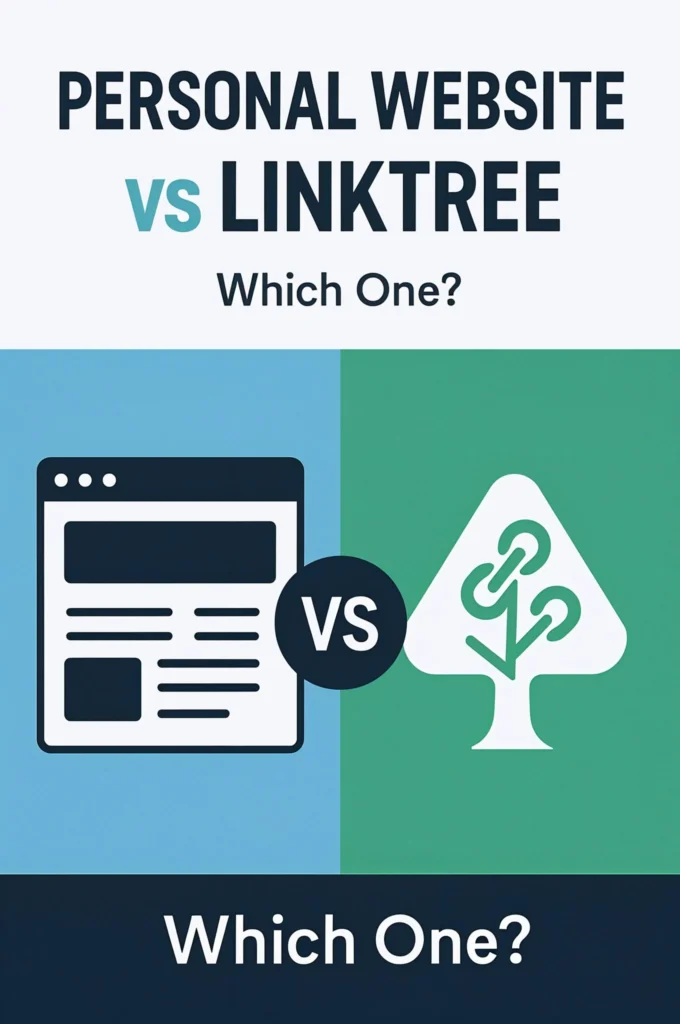
Introduction
In last few years there increase in online businesses. Indivduals also increasing their presence online and it improves social life, financial life, careers and it gives entertainment and shoping experience. e-commerse industries also improving online.there wide variety of domains and hostings, bio links are used where people can start their online presence with prior cost and do oline
businesses. Personal website and link tree both improve their online presence and connects links with online audience. They make money by helping people in their problems by posting links in instagram, twitter and facebook by gathering audience and grouping people and create customers There are some difference between them.
Personal website improves branding, it says why, where, what,who and how it offeres help to online audience. It finds people and converts into customers through lead generation, email marketing, subscribers post. Link tree is a simple and short bio tool without having confusion these links are posted in instagram, twitter, and facebook. It is mostly used for beginners in digital marketing.
How do you know which one to use. In the nexts section you will see differences in design, customization, feautures, functionality, SEO and discoverability, cost and ease of use and moneytization etc.
Due to Link tree keeps its bio link simple and short. If you are a social media influencer, creater and digital product sellers, and to keep small businesses and starters Link tree can be used. For blogs, lead magnet generators, Content creaters, freelances with big scaled businesses personal websites are used.
What is link tree and personal website
Linktree is a lightweight tool that allows you to create a single landing page with multiple clickable links. It’s most commonly used in social media bios, where platforms like Instagram, TikTok, and Twitter/X only allow one link in your profile. To direct their
audience to multiple destinations from a single bio link link tree is used. Social media influencers use it to share links to YouTube videos, affiliate products, giveaways, or podcast episodes.
A personal website is a full-fledged, standalone website—usually hosted on a custom domain like yourname.com. It represents your digital home base, often including multiple pages like About, Services, Portfolio, Blog, Testimonials, and Contact.
To establish long-term credibility, control their branding, and rank in search engines personal websites are used. Professional use it as online resume and portfolio. Coaches, freelancers, and consultants use it to sell services and share expertise through blogs or videos.
Design and Customization: Who Wins between personal website vs Linktree
In design and customization personal website wins over Link tree. Personal website can be created with wide variety of designs You can
choose layouts, add sections, upload branded graphics, change fonts, and tailor every inch to reflect your brand personality. With Linktree, you get a basic template with limited fonts, colors, and button styles. Even on the paid version, you can only customize a few design elements.
Personal website demands professionalism by your online appearance its designed to stand out and look professional. So for branding and good user experience personal website are used.
Features and Functionality in Personal website vs linkedin which one is better
In Link tree you get a set of basic features- clickable buttons, some analytics, a bio and a few themes. There is only limited email sign ups, payment processing, blogging, seo optimization. But in personal website. You can get more clients, create blogs, SEO optimization can be done, with tools like convertkit, Mail chimp, google analytics or stripe. Personal website acts as a place where people can learn about you, contact you or buy from you-all in one.
SEO and Discoverability in Personal website vs linkedin which one is better
Personal website posts, pages can be SEO Optimized and can be indexed in google. So that people type the short or long term keywords in google and see the top rated website. If SEO optimization is done good more will be the rank of website in search engines
and hence improve the dicoverability.
Cost and Ease of Use in Personal website vs linkedin which one is better.
Both Linktree and personal websites can be affordable, but they differ in what you get for your money. Linktree has a free plan with basic features, which is great for beginners. If you want more design options, analytics, and branding features, you’ll need to upgrade to a paid plan, which starts at a few dollars per month. It’s simple to set up, requires no tech knowledge, and you can have a page ready in minutes
Conversion and Monetization in Personal website vs linkedin which one is better
If your goal is to make money or convert followers into clients, a personal website gives you a lot more power. With a website, you can build landing pages, offer lead magnets, connect email marketing tools, embed payment buttons, and even sell digital products. All these tools help you move visitors from just browsing to taking action—whether that’s signing up for your newsletter, booking a service, or buying something.
Use Cases: Who Should Use What in Personal website vs linkedin which one is better
Now that we’ve explored the features and differences, let’s look at who should use Linktree and who should use a personal website. If you’re a beginner content creator, influencer, or musician who just needs a quick, mobile-friendly way to share links—Linktree is a great starting point. It’s especially helpful for Instagram, TikTok, or Twitter bios where you can’t post multiple links.